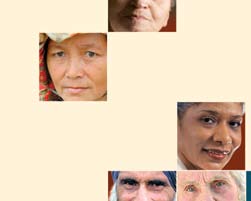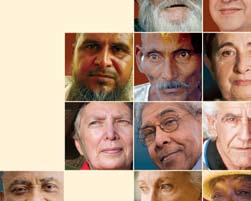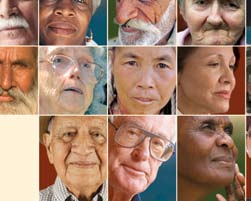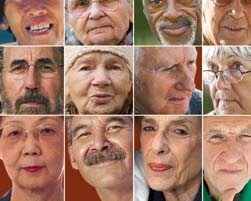
























NATIONAL INSTITUTE ON AGING
NATIONAL INSTITUTES OF HEALTH
U.S. DEPARTMENT OF HEALTH AND HUMAN SERVICES
U.S. DEPARTMENT OF STATE
Why Population Aging Matters
A Global Perspective

Contents
Foreword. . . . . . . . . . . . . . . . . . . . . . . . . . . . . . . . . . . . . . . . . 1
Overview—Our.Aging.World. .. .. .. .. .. .. .. .. .. .. .. .. .. .. .. .. .. .. .. .. .. .. .. .. . . 2
Introduction—The.Cost.of.Waiting. . . . . . . . . . . . . . . . . . . . . . . . 4
Trend.1:.An.Aging.Population. . . . . . . . . . . . . . . . . . . . . . . . . . . 6
Trend.2:.Increasing.Life.Expectancy. . . . . . . . . . . . . . . . . . . . . . 8
Trend.3:.Rising.Numbers.of.the.Oldest.Old. . . . . . . . . . . . . . . . .10
Trend.4:.Growing.Burden.of.Noncommunicable.Diseases. . . . . .12
Trend.5:.Aging.and.Population.Decline. . . . . . . . . . . . . . . . . . . .14
Trend.6:.Changing.Family.Structure. . . . . . . . . . . . . . . . . . . . . .16
Trend.7:.Shifting.Patterns.of.Work.and.Retirement. . . . . . . . . . .18
Trend.8:.Evolving.Social.Insurance.Systems. . . . . . . . . . . . . . . .21
Trend.9:.Emerging.Economic.Chal enges. . . . . . . . . . . . . . . . . .24
Endnote . . . . . . . . . . . . . . . . . . . . . . . . . . . . . . . . . . . . . . . . . .27
Suggested.Resources. . . . . . . . . . . . . . . . . . . . . . . . . . . . . . . .28




Foreword > People are living longer and, in some parts of the world, healthier lives. This represents one of the crowning achievements of the last century but also a significant challenge. Longer lives must be planned for. Societal aging may affect economic growth and many other issues, including the sustainability of families, the ability of states and communities to provide resources for older citizens, and international relations. The Global Burden of Disease, a study conducted by the World Health Organization and the World Bank, with partial support from the U.S. National Institute on Aging, predicts a very large increase in disability caused by increases in age-related chronic disease in all regions of the world. In a few decades, the loss of health and life worldwide will be greater from noncommunicable or chronic diseases (e.g., cardiovascular disease, dementia and Alzheimer’s disease, cancer, arthritis, and diabetes) than from infectious diseases, childhood diseases, and accidents.
Despite the weight of scientific evidence, the significance of population aging and its global implications have yet to be fully appreciated. There is a need to raise awareness about not only global aging issues but also the importance of rigorous cross-national scientific research and policy dialogue that will help us address the challenges and opportunities of an aging world.
Preparing financially for longer lives and finding ways to reduce aging-related disability should become national and global priorities. Experience shows that for nations, as for individuals, it is critical to address problems sooner rather than later. Waiting significantly increases the costs and difficulties of addressing these challenges.
This report paints a compelling picture of the impact of population aging on nations. It provides a succinct description of population trends that are transforming the world in fundamental ways. We hope this information will stimulate dialogue about biomedical, economic, and behavioral issues and encourage international study to determine the best ways to address this universal human experience. We trust that members of the global community will be inspired to share their recommendations and their experiences so that we can all plan for the aging of our world’s population. We are, after all, planning for our own futures.
Paula J. Dobriansky, Ph.D.
Under Secretary for Democracy and Global Affairs
Department of State
Richard M. Suzman, Ph.D.
Richard J. Hodes, M.D.
Director, Behavioral and Social Research Program
Director
National Institute on Aging
National Institute on Aging
National Institutes of Health
National Institutes of Health

o v e r v i e w
Our Aging World
We.are.aging—not.just.as.individuals.or.communities.but.
as.a.world ..In.2006,.almost.500.mil ion.people.worldwide.
were.65.and.older ..By.2030,.that.total.is.projected.to.
increase.to.1.bil ion—1.in.every.8.of.the.earth’s.inhabitants ..
Significantly,.the.most.rapid.increases.in.the.65-and-older.
population.are.occurring.in.developing.countries,.which.
wil .see.a.jump.of.140.percent.by.2030 .
. . . . w H y P o P U l A t I o N A G I N G m A t t e R S : A G l o B A l P e R S P e c t I v e A.Host.of.Chal enges
l Family structures are changing. As people
live longer and have fewer children, family
While global aging represents a triumph of
structures are transformed, leaving older
medical, social, and economic advances over
people with fewer options for care.
disease, it also presents tremendous chal enges.
l Patterns of work and retirement are shifting.
Population aging strains social insurance and
Shrinking ratios of workers to pensioners
pension systems and chal enges existing models of
and people spending a larger portion of
social support. It affects economic growth, trade,
their lives in retirement increasingly strain
migration, disease patterns and prevalence, and
existing health and pension systems.
fundamental assumptions about growing older.
l Social insurance systems are evolving. As
Using data from the United Nations, U.S. Census
social insurance expenditures escalate, an
Bureau, and Statistical Office of the European
increasing number of countries are evaluating
Communities as well as regional surveys and
the sustainability of these systems.
scientific journals, the U.S. National Institute
l New economic challenges are emerging.
on Aging (NIA), with input from demographers,
Population aging will have dramatic effects
economists, and experts on aging, identified
on social entitlement programs, labor
nine emerging trends in global aging. Together,
supply, trade, and savings around the globe
these trends present a snapshot of challenges
and may demand new fiscal approaches to
and opportunities that clearly show why
accommodate a changing world.
population aging matters.
A.Window.of.Opportunity
l The overall population is aging. For the first
time in history, and probably for the rest of
Some governments have begun to plan for the
human history, people age 65 and over will
long term, but most have not. The window of
outnumber children under age 5.
opportunity for reform is closing fast as the pace
l Life expectancy is increasing. Most
of population aging accelerates. While Europe
countries, including developing countries,
currently has four people of working age for
show a steady increase in longevity over
every older person, it will have only two workers
time, which raises the question of how much
per older person by 2050. In some countries
further life expectancy will increase.
the share of gross domestic product devoted to
l The number of oldest old is rising. People
social insurance for older people is expected to
age 85 and over are now the fastest growing
more than double in upcoming years. Countries
portion of many national populations.
therefore have only a few years to intensify
l Noncommunicable diseases are becoming a
efforts before demographic effects come to bear.
growing burden. Chronic noncommunicable
diseases are now the major cause of death
The chal enges may seem daunting, but a host
among older people in both more developed
of opportunities await us as wel . For instance,
and less developed countries.
countries that have begun to address issues of
l Some populations will shrink in the next
population aging can share their experiences.
few decades. While world population
There are exciting opportunities for economic
is aging at an unprecedented rate, the
expansion and cross-national col aboration as
total population in some countries is
wel , but we must act now or the costs of waiting—
simultaneously declining.
financial and social—wil be overwhelming.
o v e R v I e w — o U R A G I N G w o R l D

i n t r o d u c t i o n
The Cost of Waiting
Global.aging.is.a.success.story ..People.today.are.living.
longer.and.generally.healthier.lives ..This.represents.
the.triumph.of.public.health,.medical.advancement,.and.
economic.development.over.disease.and.injury,.which.
have.constrained.human.life.expectancy.for.thousands.
of.years ..
. . . . w H y P o P U l A t I o N A G I N G m A t t e R S : A G l o B A l P e R S P e c t I v e

But sustained growth of the world’s older
population also presents chal enges. Population
aging now affects economic growth, formal and
informal social support systems, and the ability
of states and communities to provide resources
for older citizens. Nations must quickly recognize
the scope of the new demographic reality and
adjust current policies accordingly. Experience
has shown that such adjustments may be
painful—changes in retirement ages and medical
benefits, for example, are not widely popular. But
experience also shows that it is easier to address
European Commission and the Economic Policy
problems sooner rather than later, when the cost
Committee submitted a report to European
of waiting may become insurmountable.
Finance Ministers with new projections of
economic and budgetary costs for European
We can think about preparing for older age
Union (EU) member states. While Europe
on both an individual and societal level. On
currently has four people of working age for
an individual level, people need to focus on
every older citizen, it will have only two workers
preventive health and financial preparedness.
per older citizen by 2050 as a result of the baby
We know that many individuals approach older
boom generation retiring and life expectancy
age with little or no savings. A simple example
increasing. Given current policies, the pension,
illustrates the financial cost of waiting to save
health, and long-term care costs associated
and the value of a more farsighted perspective.
with an aging population will lead to significant
A 40-year-old worker who begins to save
increases in public spending in most member
$10,000 per year will accumulate $700,000 by
states over the next half century. Gross domestic
the time he is 70 years old, assuming an interest
product growth rates are projected to fall across
rate of 5 percent per year. If he had begun saving
the EU, and in the absence of policy changes, the
when he was 30 years old, he would only have
potential EU economic growth rate will be cut in
needed to save $5,500 per year to accumulate
half by 2030.
the same amount by age 70.
While some countries have initiated changes in
Calculating the cost of waiting at the national
retirement age that promise to ease the burden
level is much more complex, but similar
of public spending, the EU analysis emphasizes
reasoning applies. Just as for individuals, small
that such changes alone are inadequate. During
and gradual changes distributed over a longer
the next few years, countries must exploit a
time horizon are more easily absorbed by a
fast-closing window of opportunity to intensify
country than sudden and more substantial
reform before demographic effects come to bear.
actions required to meet a particular savings
The EU report notes that, similar to the impact
target over a shorter time horizon. Countries and
of an individual worker delaying savings, delays
international organizations are now developing
at the national level will increase the costs of
detailed models in recognition of looming costs
adjustment and shift an enormous economic
and the need for pension reforms to ensure
burden to the next generation of workers and
sustainable old-age support. In 2006, the
taxpayers.
I N t R o D U c t I o N — t H e c o S t o F w A I t I N G




t r e n d
An Aging Population
1
Since.the.beginning.of.recorded.human.history,.young.
children.have.outnumbered.older.people ..Very.soon.this.
wil .change ..For.the.first.time.in.history,.people.age.65.
and.over.wil .outnumber.children.under.age.5.(Figure.1) ..
This.trend.is.emerging.around.the.globe ..Today.almost.
500.mil ion.people.are.age.65.and.over,.accounting.for.
8.percent.of.the.world’s.population ..
Figure 1:
yoUNG cHIlDReN AND olDeR PeoPle AS A
PeRceNtAGe oF GloBAl PoPUlAtIoN
'%
6<:+*
&*
&%
6<:1*
*
&.*% &.+% &.,% &.-% &..% '%%% '%&% '%'% '%(% '%)% '%*%
Source:.United.Nations.Department.of.Economic.and.Social.Affairs,.Population.Division .. W
Population Prospects. The 2004 Revision. .New.York:.United.Nations,.2005 .
. . . . w H y P o P U l A t I o N A G I N G m A t t e R S : A G l o B A l P e R S P e c t I v e By 2030 the world is likely to have 1 bil ion older
Figure :
people, accounting for 13 percent of the total
tHe SPeeD oF PoPUlAtIoN AGING
population. While today’s proportions of older
Number of years for population age + to increase
people typical y are highest in more developed
from % to 1%
countries, the most rapid increases in older
9ZkZadeZY8djcig^Zh
populations are occurring in the less developed
world. Between 2006 and 2030, the number of
;gVcXZ&-+*"&.-% &&*
older people in less developed countries is projected
to increase by 140 percent as compared to an
HlZYZc&-.%"&.,* -*
increase of 51 percent in more developed countries.
6jhigVa^V&.(-"'%&& ,(
Population aging is driven by declines in fertility
JH&.))"'%&( +.
and improvements in health and longevity. In
8VcVYV&.))"'%%. +*
more developed countries, declines in fertility
that began in the early 1900s have resulted in
=jc\Vgn&.)&"&..) *(
current fertility levels below the population
EdaVcY&.++"'%&( ),
replacement rate of two live births per woman.
Perhaps the most surprising demographic
J@&.(%"&.,* )*
development of the past 20 years has been the
HeV^c&.),"&..' )*
pace of fertility decline in many less developed
countries. In 2006, for example, the total fertility
?VeVc&.,%"&..+ '+
rate was at or below the replacement rate in
44 less developed countries.
9ZkZade^c\8djcig^Zh
Most of the more developed nations have had
6oZgWV^_Vc'%%%"'%)& )&
decades to adjust to this change in age structure
8]^aZ&..-"'%'* ',
(Figure.2) .. For example, it took more than a
century for France’s population age 65 and over
8]^cV'%%%"'%'+ '+
to increase from 7 to 14 percent of the total
?VbV^XV'%%-"'%(( '*
population. In contrast, many less developed
countries are experiencing rapid increases in the
Ijc^h^V'%%-"'%(' ')
number and percentage of older people, often
Hg^AVc`V'%%)"'%', '(
within a single generation. The same demographic
aging process that unfolded over more than a
I]V^aVcY'%%("'%'* ''
century in France wil occur in two decades in
7gVo^a'%&&"'%('
'&
Brazil. In response to this “compression of aging,”
institutions must adapt quickly to accommodate
8dadbW^V'%&,"'%(, '%
a new age structure. Some less developed nations
H^c\VedgZ'%%%"'%&.
&.
wil be forced to confront issues, such as social
support and the al ocation of resources across
generations, without the accompanying economic
Source:.Kinsel a.K,.Gist.Y .. Older Workers, Retirement, and
Pensions. A Comparative International Chartbook. .Washington,.
growth that characterized the experience of
DC:.U .S ..Census.Bureau.and.U .S ..National.Institute.on.Aging,.
aging societies in the West. In other words, some
1995;.and.U .S ..Census.Bureau ..International.Data.Base ..
Available.at:.http://www .census .gov/ipc/www/idbnew .html ..
countries may grow old before they grow rich.
Accessed.January.8,.2007 .
t R e N D 1 : A N A G I N G P o P U l A t I o N


t2rend Increasing Life Expectancy
Some.nations.experienced.more.than.a.doubling.of.average.
life.expectancy.during.the.20th.century ..Life.expectancy.
at.birth.in.Japan.now.approaches.82.years,.the.highest.
level.among.the.world’s.more.developed.countries,.and.
life.expectancy.is.at.least.79.years.in.several.other.more.
developed.countries ..
l A shift from the predominance of infectious
and parasitic diseases to the growing impact
of noncommunicable diseases and chronic
conditions.
The health transition shifts the human survival
curve so that the chances of surviving another










































